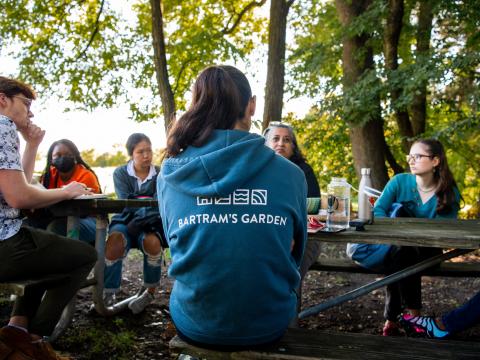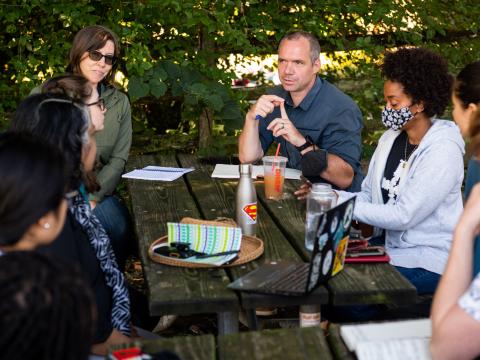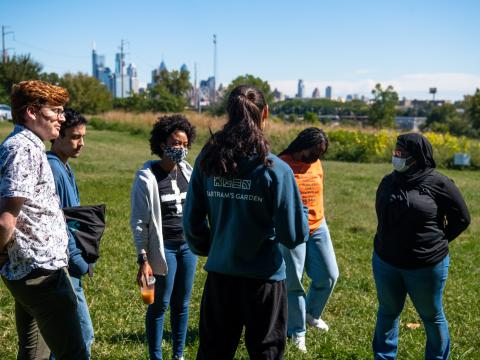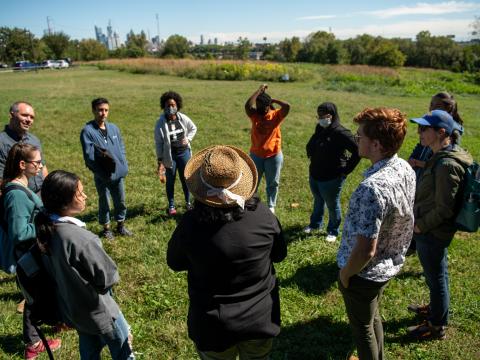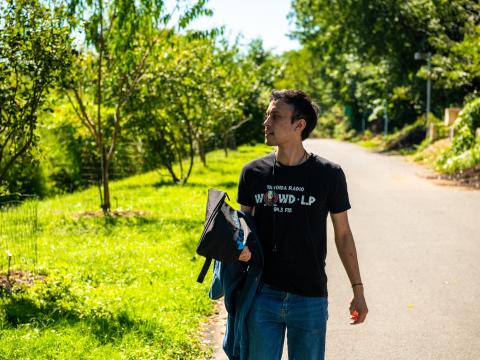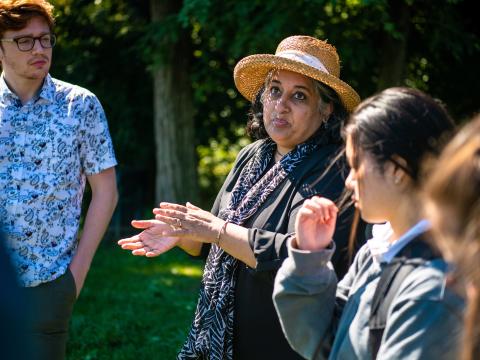Leaning into Diversity, Equity, and Inclusion at Bartram's Garden
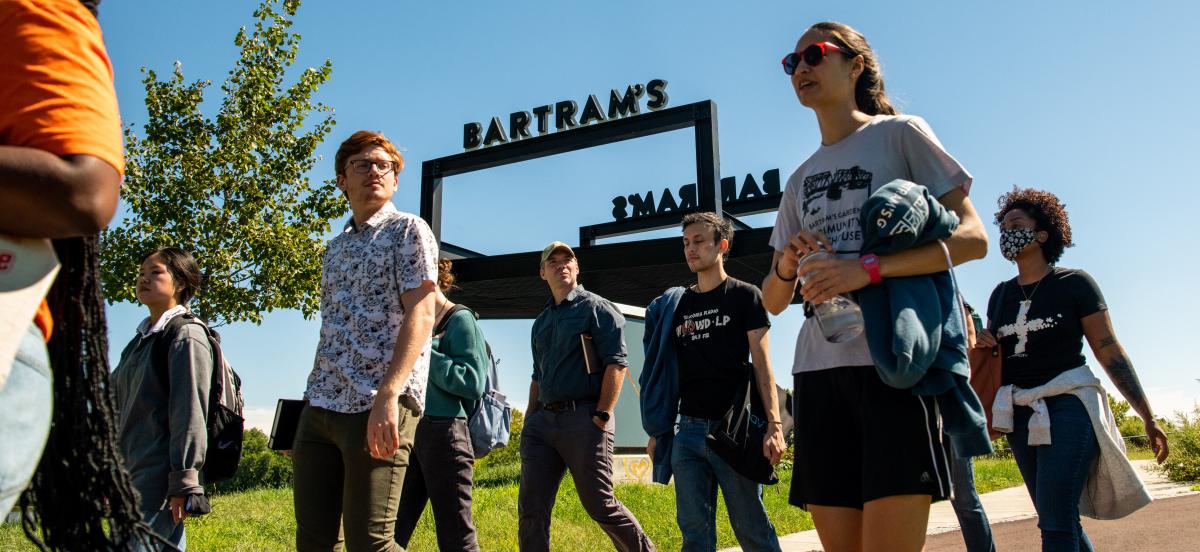
Details
Philadelphia Peace, Justice, and Equity Fellows (PJEFs) traveled to Bartram's Garden to reflect on their respective fellowships and the work they have before them.
The drive from Haverford College to Bartram’s Garden serves as a reminder that Haverford is a bubble. Last week, five Philadelphia Peace, Justice, and Equity Fellows (PJEFs) traveled there to reflect on their experience working for their respective non-profits and, most importantly, the work they have yet to do. They loaded into a Haverford College van that took them from the leafy suburbs of Ardmore to the dense city streets of Kingsessing. To travel from one community to the other is to see the face of income inequality in the United States.
For the five fellows, it was not their first run-in with this visage. Their fellowships each seek to rectify historical injustices in Philadelphia using divergent methods. The trip to Bartram’s garden offered the opportunity to ground their work in the land of Philadelphia. I mean this literally. Bartram’s garden receives protection as a National Historic Landmark from the development and industrialization that has engulfed the lower Schuylkill River. It remains a pristine public garden for nearby community members to explore. Walking through its well-trodden paths, canopied by trees, it’s hard not to feel history vibrating beneath your feet.
It is a history by turns heartening and horrid. John Bartram moved to the farm in 1728 to cultivate a botanical garden. He made numerous expeditions into the American frontier to catalogue species for the benefit of European botany. So prolific were his discoveries that in 1765, King George III appointed him “His Majesty’s Botanist for North America.” The word “discoveries” belongs in quotes, for indigenous people knew of these creatures long before Bartram. The history of indigenous peoples cry out from the soil but features rarely in the panels telling the history of the land. One display, describing the travels of John Bartram’s fifth son William, speaks in the same winsome breath of his encounters with “alligators, Indians, and international intrigue.”
Bartram’s Garden Executive Director Maitreyi Roy is trying to fix that. She sat down with the five fellows in the shade provided by some trees to describe their efforts to tell the whole story of the land, a history which predates settler colonialism by countless generations. Simultaneously, she hopes to articulate a more inclusive future for the public garden. When she began working as Executive Director, community members in Kingsessing thought Bartram’s Garden was private property in which they were unwelcome. It took consistent community events and outreach to increase the number of local visitors at Bartram’s Garden. Now, a recent study indicates visitor demographics are roughly equivalent to the demographics of Philadelphia. On any given day, dozens can be seen hiking the garden’s trails, fishing in the Schuylkill, or kayaking down the river.
Grounding himself in a community is crucial for the work being done by Ben Pham Roodman (Class of ’22). He works with the Kensington Corridor Trust, an organization which seeks to ameliorate the effects of gentrification in the Kensington neighborhood. It hopes to do this by purchasing properties in the area before they are snapped up by developers and, over time, relinquishing them to a board of community members who can control how the properties are used. It is a unique model without precedent, as far as Roodman knows. Most importantly, it avoids the saviourism of so much urban activism. They are “neither manipulative, outside, private interests,” says Roodman, “nor are we just random people coming in off the street because the neighborhood has plenty of both of those.” Hearing about Bartram’s community outreach efforts reminded him of the value of community input, a crucial aspect of his fellowship.
For Aishah Collison-Cofie (Class of ’22), Bartram’s Garden made her fellowship feel “more real and more connected to the city.” She works with the Philadelphia Department of Public Health to address healthcare inequity in the city. In particular, she focuses on the higher rates of maternal mortality among African-American women. Her day-to-day work involves sitting in on the department’s meetings and compiling data on healthcare inequality, but Bartram’s Garden reminded her of the people she is helping through her work. “I’m actually doing work in the city, with actual people,” she said, “and the work I’m doing is enough to help their lives in some way.”
The same goes for Lulu Obaditch (Class of ’22), who works for the Human Rights Coalition and the Abolitionist Law Center. The two organizations share similar missions and even some co-founders. Namely, they hope to end, “death by incarceration, otherwise known as life without parole.” Obaditch supports these efforts by engaging in “both local and statewide organizing” that advocates for the rights of the imprisoned. Traveling to Bartram’s Garden reminded her that far too many people in prison will never be able to enjoy a simple walk through its trails.
PJEF is a program of the Center for Peace and Global Citizenship. Fellows work with organizations advancing inclusion and fighting racist exclusion in the Philadelphia region. Their work builds off the foundation of a summer internship, continues eight hours per week during the academic year, and is supplemented by a professional development series. That series includes events like the one chronicled here, at Bartram’s Garden on Friday. Academic year 22-23 Fellows will be selected during the spring term.
